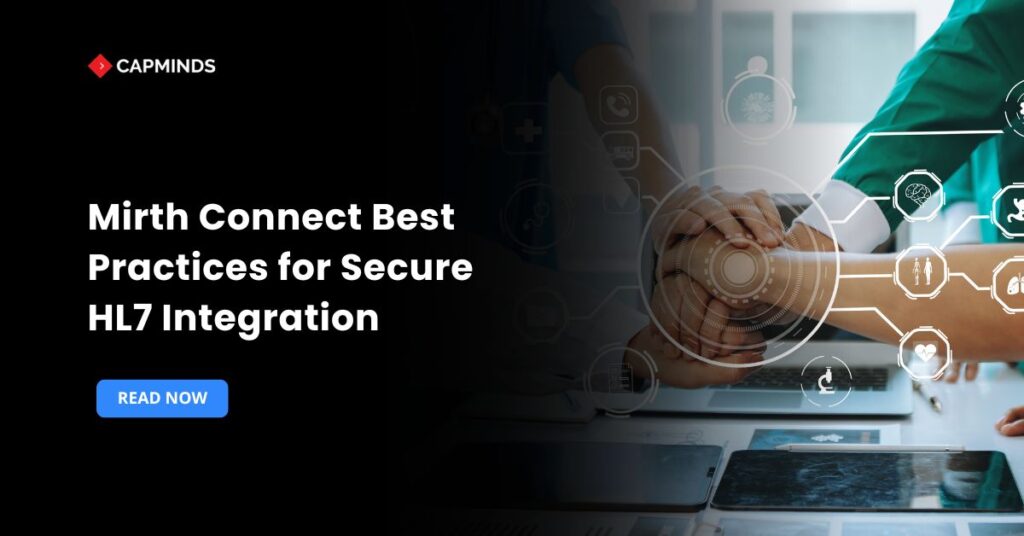Mirth Connect Best Practices for Secure HL7 Integration
The smooth and safe transfer of data in a complicated structure of healthcare is not a benefit, but a requirement. The core of this interchange is commonly Mirth Connect integration, an HL7 open-source integration engine that uses powerful routing, filtering, transformation, and translation of healthcare messages.
The industry becomes more dependent on the HL7 integration and innovative standards such as the FHIR, and the knowledge of how to implement Mirth Connect securely becomes the key to the success of strong interoperability in healthcare.
In this blog post, you’ll know the best practices that would make sure your Mirth deployments are efficient in addition to being compliant and resistant to security threats.
HL7 Interface Security Challenges
Mirth Connect provides amazing flexibility and power to process healthcare data; there are several difficulties when managing the security of integrating HL7 interface engines. Healthcare data is very sensitive in nature, hence it makes it an ideal target of cyberattack. Common challenges include:
- Sensitivity to Eavesdropping – Unsecured channels may disclose PHI as it goes between the systems.
- Unauthorized Access – Insecure authentication systems may enable other actors to have access to your integration points.
- Data Tampering – This would allow the data to be manipulated on the way to the destination, resulting in the wrong patient records or treatment decisions.
- Absence of Auditability – Data is not adequately logged, and therefore, tracking of the flow of data, detection of security incidents, and regulatory compliance may be hard.
- Complexity of HL7 – HL7 v2 messages and their numerous dialects are complex and can be easily configured in the wrong manner, causing security vulnerabilities.
- Credential Management – Credential management is always a challenge in ensuring that the credentials have to be safely stored and managed across diverse interconnected systems.
Top 7 Mirth Connect Best Practices for Security
1. Use SSL/TLS on the Entire External Communications
All network communication with Mirth Connect must be encrypted by using Secure Socket Layer (SSL) or Transport Layer Security (TLS), and in particular when connecting to systems or networks beyond those they trust.
Mirth Connect also has built-in support of TLS on most connectors, such as LLP Listener, HTTP Sender/Receiver. Set up your channels with secure protocols such as HTTPS when connecting to web services, as well as STARTTLS when connecting to email services or databases where needed.
2. Authentication and Authorization
Mutual TLS (mTLS) – When the integrations are of high sensitivity, it is a good idea to use mutual TLS, where both the client and the server authenticate each other with the help of digital certificates.
User Authentication – To gain access to the Mirth Connect Administrator, a strong password policy should be enforced, multi-factor authentication should be enforced where available (or a proxy), and integrated with centralized identity management systems such as LDAP or Active Directory where applicable.
Role-Based Access Control – Grant user access in Mirth Connect depending on the user role. Not all people should have the complete administrative privilege to develop, edit, or implement channels.
3. Data Encryption at Rest
Mirth Connect operates on data in transit; there may be instances where data may sit on disk, such as message store, database backups.
Make sure that the infrastructure (servers, databases) under which Mirth Connect stores any sensitive data has adequate encryption at rest. This could include disk encryption or database-level encryption protection.
Related: Mirth Connect for Healthcare Integration: A Complete 2025 Guide
4. Full Logging and Audit Trails
Mirth Connect Logging – This is used to configure the internal logging of Mirth Connect so that all the relevant events can be captured, such as channel deployment, message processing errors, connection attempts, and configuration changes.
System-Level Logging – Add operating system logs and network device logs to the logs of Mirth Connect.
Centralized Log Management – Pass all logs to a Security Information and Event Management (SIEM) system, where they are centrally correlated and analyzed, and suspicious activities are alerted. This plays a vital role in data exchange that is HIPAA-compliant.
5. Proactive Monitoring and Alerting
- Bad passwords for the Mirth Connect Administrator
- An abnormal number of messages or frequency
- Channel errors or failures
- Illegal modification of configuration
Notification of certificate expiration. Proactive monitoring enables quick detection and reaction to organizations that might have security incidents.
6. Periodic Security Audits and Penetration Testing
Conduct security audits and penetration tests regularly on the Mirth Connect environment and systems. Those exercises will be able to reveal weak points that a set of automated tools would not detect and help prove that your security controls are effective. Use the services of third-party professionals who will make an objective judgment.
7. Secure Mirth Connect Configuration and Channel Design
- Least Privilege Principle – Set up channels and connectors with the least permissions needed to conduct their task.
- Input Validation – This is the second step to be taken to ensure that all the incoming data is properly validated so that injection attacks or malformed messages will not interfere with your system.
- Error Handling – Have well-developed error handling systems, which record information, but do not display sensitive information in error messages to systems outside the organization.
- Secrets Management – Do not hard-code sensitive credentials in channel configurations. Take advantage of the configuration map and external secure credential stores of Mirth Connect.
Optimizing Scalability and Performance
Security is the most important, but Mirth Connect setup must also be configured to address performance and scalability in cases where there are large volumes of HL7 integration traffic.
Effective Channel Organization
Organize your channels rationally. Decomposing complicated work processes into smaller, manageable channels. Single channels should not be too complicated because they are hard to debug and maintain.
Message Queuing Strategies
Mirth Connect provides message persistence for queues. In high-throughput cases, ensure that the database is performance-tuned for the message to store or look at external queuing products if Mirth Connect internal persistence is identified. Scalability can also be achieved using a clustered architecture, using several Mirth Connects that use the same database.
Resource Allocation
Make sure that Mirth Connect instances have enough CPU, memory, and disk I/O to support the expected load of messages without loading a performance bottleneck.
Secure HL7 Integration Services for Your Interoperability Goals
At CapMinds, we don’t just secure your integrations; we help you build a connected healthcare ecosystem that performs seamlessly, scales intelligently, and stays compliant at every level.
Our Mirth Connect integration services empower healthcare providers, EHR vendors, and health networks to exchange data effortlessly while staying HIPAA- and FHIR-aligned.
With years of interoperability expertise, CapMinds delivers end-to-end HL7 integration services designed for real-world healthcare complexity, from data mapping to performance tuning and secure deployment.
Our Interoperability & Integration Services Include:
- Mirth Connect Integration Services – Design, configuration, and optimization of secure HL7/FHIR channels.
- HL7 Integration Services – Custom interface development for EHR, labs, imaging, and third-party systems.
- FHIR Integration Services – FHIR-native API connections for next-gen digital health interoperability.
- Mirth Connect Managed Services – Ongoing monitoring, scalability, and compliance management.
Partner with CapMinds to transform your healthcare data exchange securely, intelligently, and without limits.




